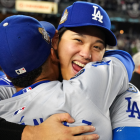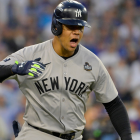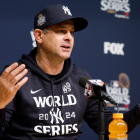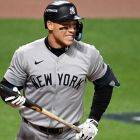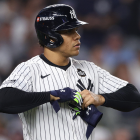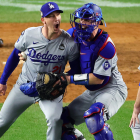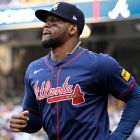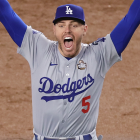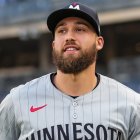Actual spring training games begin on Monday, so what better time than to start running through our annual team-by-team previews? We'll run these in reverse order of 2015 finish, so first up is the Philadelphia Phillies.
After winning five consecutive NL East titles, the Phillies fell to .500 in 2012 and then 73-89 the following two seasons. As they've entered a full-on rebuild, things bottomed out at 63-99 last season. That was the worst record in baseball and the worst in Philly since 1972.
Along the way, Pete Mackanin replaced Ryne Sandberg as manager and was eventually named the permanent manager instead of interim. He'll man a still-rebuilding team in 2016.
The Lineup
Rarely do we ever see a team run out a lineup even as many as 20 times in a season for various reasons these days, so please keep in mind this is a rough outline of what looks like the Phillies best bet right now.
1. Cesar Hernandez, 2B
2. Odubel Herrera, CF
3. Maikel Franco, 3B
4. Ryan Howard, 1B
5. Aaron Altherr, LF
6. Cameron Rupp, C
7. Peter Bourjos, RF
8. Freddy Galvis, SS
Obviously Carlos Ruiz is still in the catching picture. Darin Ruf looks to be a platoon partner with the lefty Howard while Andres Blanco and Cody Asche will see plenty of time as well. Given his immense upside and that this is a team in a rebuild, all eyes will be on the eventual promotion of shortstop J.P. Crawford.
Crawford is widely regarded as a top-10 prospect in all of baseball and finished the 2015 season in Double-A, where he hit .265/.354/.407 with 21 doubles, seven triples, five homers and seven steals in 86 games. He walked more than he struck out, which is beautiful in such a young prospect. He likely starts in Triple-A this season, but we'll probably see him for around a half season in the bigs.
In all, this offense is lacking to begin the season. This isn't shocking. There are, however, elements here worth a look. Franco was great in a half season as a rookie. Herrera was a wonderful surprise, morphing from a Rule-5 middle infielder into a very good everyday center fielder. Altherr had a very good offensive year in the minors and flashed some upside in his brief MLB stint and of course there's Crawford.
The Phillies ranked 13th in the NL in runs last season and it's hard to see them being much better as a whole this year, but by the end of 2016, we will start to see the proverbial light at the end of the tunnel.
The Rotation
The Phillies rotation last year was awful. There's just really no reason to try and be nice about it. They posted a 5.23 ERA among starting pitchers, which was only better than the Rockies (5.27). This time around, there's hope for improvement for several reasons. Let's look:
1. Aaron Nola, RHP
2. Jeremy Hellickson, RHP
3. Charlie Morton, RHP
4. Jerad Eickhoff, RHP
5. Vincent Velasquez, RHP
Instead of simply finding warm bodies to throw into the fire behind ace Cole Hamels like they did last season, this time around there's more purpose. Nola was the seventh overall pick in the 2014 draft and has ace upside. In 13 starts last season as a rookie, he was 6-2 with a 3.59 ERA and 1.20 WHIP. Eickhoff also enjoyed success as a rookie starter last season, posting a 2.65 ERA and 1.04 WHIP in eight starts. Velasquez wasn't as good, but still had a 4.03 ERA in seven starts and he's only 23.
So right there, the Phillies have three young pitchers who can form 60 percent of their rotation moving toward the future. Hellickson and Morton are the veteran placeholders, but it's fair to say they have much more upside than the likes of Aaron Harang and Jerome Williams at this point. Matt Harrison can also factor in if he can return strongly from a back injury.
More depth options: Adam Morgan, Severino Gonzalez, Alec Asher and David Buchanan.
How about some prospect impact? There could be. Jake Thompson was 5-1 with a 1.80 ERA in seven starts for Double-A Reading last season. The 6-foot-4 righty might be up early in the season to show his stuff. There's also former number one overall pick Mark Appel, who has yet to put it all together in the minors for extended stretches but obviously has the ability -- hence being picked first overall out of Stanford in 2013.
The rotation won't be great this year by any stretch, but there's enough young talent here to believe that, come September, the City of Brotherly Love will have optimism for a 2017 break through.
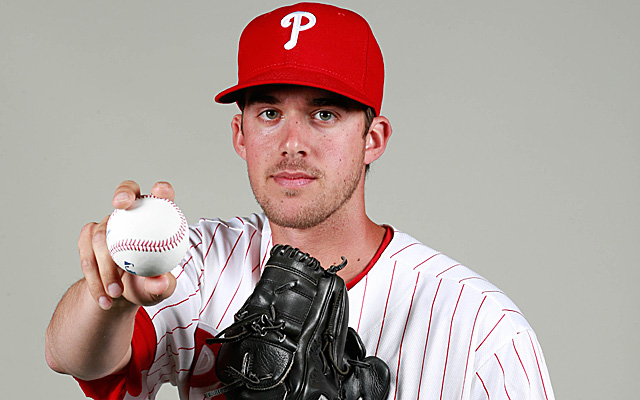
The Bullpen
Things are a bit more up in the air here. After trading Jonathan Papelbon last summer, the path was clear for Ken Giles to become the next Phillies closer, but he was also jettisoned last winter, so now it's David Hernandez who will take over. He was a great setup man for Arizona circa 2011-12, but he's had Tommy John surgery since then. Last season, in his first year back, he had a 4.28 ERA and 1.31 WHIP. He also had 33 strikeouts in 33 2/3 innings and we know that, generally speaking, the second year back is when there's a return to form.
Behind Hernandez, there's former closer Edward Mujica along with holdovers Luis Garcia and Jeanmar Gomez. The long reliever looks to be Brett Oberholtzer and there's otherwise a mixed bag of spare parts.
This isn't to say the bullpen can't be successful. Relievers are volatile. Seemingly random names pop up each year as quality relievers. At the very least, Hernandez and Garcia have the capability to be a quality back-end duo.
The Outlook
Most projection systems have the Phillies either as the worst or one of the worst teams in baseball again this season and they won't be far off. At this stage of the rebuild, they just aren't ready to compete.
As noted several times above, though, with the rebuild starting to come into focus, we can start to see which players will be part of the future. Much like Jose Altuve with the Astros or Anthony Rizzo with the Cubs during recent rebuilds, these Phillies have already shown us Franco and Nola as nucleus members. This season will be a big one in terms of seeing which players can be added to the mix. We'll know a lot more by season's end about the state of the rebuild, too, and whether 2017 or 2018 are realistic target years for a return to contention.
In 2016, however, even 70 wins would be considered a success.








